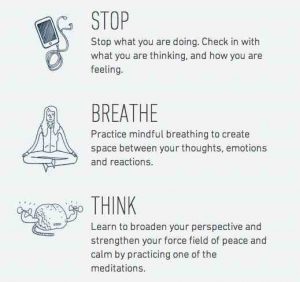Mindfulness brings awareness to what you are doing. With that clarity comes the possibility of choice. You can learn to intercept unhelpful, unwanted habits and cultivate positive ones. As you learn to do that with meditation, you can translate it to any activity, whether it’s playing sports, writing computer code, or listening to your child when they come home from school.
A Ten Minute Mindfulness Meditation
Mindfulness has been practiced for thousands of years through meditation. Meditation is a lab for the mind that produces awareness in a concentrated form.
This exercise is a meditation that will help you strengthen your capacity for awareness so that you can cultivate mindfulness in your daily life.
Mindfulness Meditation
- Find a place where you can be undisturbed for at least ten minutes. Sitting in a chair where you can be upright yet relaxed, assume a comfortable posture. Allow your body to be at ease.
- Gently close your eyes and turn your attention inward. Sense how your body feels in this moment. Mindfulness is a quality of attention that’s allowing, inviting, curious about what is. So as you pay attention to your body, see if you can bring a quality of attention that’s accepting and allowing of how things are in this moment.
- Move your attention through your whole body, noticing where you may be holding any unnecessary tension, inviting your belly and shoulders to relax, softening the muscles around your eyes and face, relaxing your jaw.
- Sit with awareness of your body, and notice that it is naturally breathing by itself, your breath effortlessly coming and going. Allow your breath to be exactly as it is, and bring your full attention to it. Notice how your breathing is in this moment. Is it long or short, deep or shallow, relaxed or tense? Notice how your breath changes each time you breathe.
- Be with your breath as though you were encountering it for the first time, as if this were the first breath you ever took.
- Notice where you feel your breath most clearly. Is it at the nostrils as the cool air enters and warm air leaves your nose? Or in the back of your throat? Or in the lifting and expanding of your upper chest when you inhale or the contraction of your chest when you exhale? Or perhaps in the rising and falling of your abdomen?
- Establish your attention in the place where you feel your breath most clearly. Pay attention to the full duration of an in breath and an out breath. Stay present if there’s a pause between breaths; simply be aware of your body sitting until the next in breath comes. When you notice sounds appearing and disappearing, sensations arising and passing, emotions, thoughts, and images coming and going, just acknowledge them and then bring your attention back to your breath.
- If it is helpful, you can make a soft mental note of “in” when you inhale and “out” when you exhale. Make sure the mental note takes only about 5 percent of your attention and that the majority of your focus is on feeling the actual sensations of your breath.
- If your attention becomes absorbed in thoughts, memories, or plans, simply reestablish a connection with your breath. When you notice that thinking is happening, that itself is a moment of mindfulness. There is no need to judge yourself; just bring your attention back to your breath.
- As a way of deepening your attention to your breath, focus on the very beginning of an in breath. Gently sustain your attention just for that one in breath. Then notice the beginning of an out breath, and sustain your attention just for that one out breath.
- No matter how many times your attention wanders or how far you become lost in thought, it takes only a moment to return to mindfulness, to the present moment. Return to the present moment by reestablishing a connection with your body and then reconnecting with your breath.
- It’s natural for the mind to think. Mindfulness practice is coming into wise relationship with thought and with everything that happens in your experience. So without judgment or criticism, bring your attention back again and reestablish a connection with your breath. Connect and sustain your attention with each in breath and each out breath. Notice how each breath is different from the previous one. Allow your awareness to be absorbed by and permeate each breath. Pay attention to the fine sensations and nuances of your changing breath. If you find yourself becoming tense or trying to control your breath, relax a little, making sure there ’s ease in your body.
- In the last few minutes of the meditation, let go of what’s gone on before and just begin again. Allow yourself to simply be aware of sitting and breathing. Rest in this natural awareness of your breath as it comes and goes.
- As you begin to bring this meditation to a close, take a moment to sense your body, your heart, and your mind. Notice the effect of this exercise.
- When you feel ready to end this meditation, slowly open your eyes, and gently move and stretch.
Bring the same quality of mindful attention you used in this meditation to everything you encounter. See if you can sustain this mindfulness as you move through your day. Remember that the more you do mindfulness training, the more you’ll be able to bring mindful awareness into the rest of your life.
*original article by Mark Coleman
* Click here to find out more about Terezia Farkas and Depression Help


